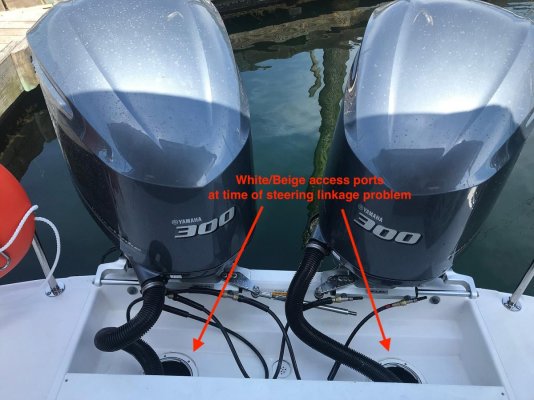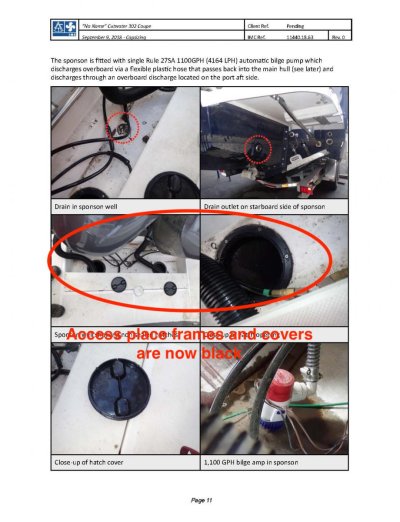I'll repeat that the sponson in this boat is used to mount the engine package and swim platform. True some of it sits below the water line, but that's simply because of its size and how its mounted to the hull. That doesn't mean it has a role in providing buoyancy.
Perhaps what you are saying is that the vessels stability and vulnerability to taking on water is not dependent on the added buoyancy of the sponson, and further that it wouldn't be degraded by the additional weight of a fully flooded sponson? Because that's the only wiggle room you have here. The flotation provided by the sponson is equal to the weight of the engines. So removing the sponson flotation would be equivalent to hanging TWO MORE engines off the back of the boat. And fully flooding the sponson would be equivalent to hanging FOUR MORE engines off the back of the boat. That's going to change the waterline on the boat - it's physics and there is simply no doubt about it. The second surveyor even calculated how much the waterline would change, and as I recall it was about 170cm, or 6-7". And that's just flooding to the waterline in the sponson, so only removing the added flotation (equivalent to adding two more engines).
You don't seem to understand this, so I don't think you are a good judge of it's impact. I think the two marine surveyors, both of whom concluded it would have an impact, are more reliable judges.
The dealer also installed a Panoptix Garmin transducer, and I spoke to Port boat house about their installs while I was researching the best transducer install point for my boat while commissioning. I know they prefer to put these transducers on fisherman's boats and I wonder if they accessed the sponson during the install for some reason, breaking his factory white access hatches. I cant even get my sponson hatches off by hand, so maybe they broke them trying.
Regardless, I maintain the hatch issue doesnt have any bearing on why or how this boat sunk...its not germane to the conversation.
Anything to do with the Panoptix transducer is a Red Herring. Both survey's inspected all the hull fittings and concluded all were in good shape.
It may be true that the hatches had nothing to do with the sinking, but I think they remain a candidate. We know the hatches were damaged at some point and replaced - it's called out in one of the work lists. That's no big deal and happened well before the sinking. The only question would be whether the replaced hatches were improperly installed, or of a different design than original that was inappropriate for the application. And the ultimate question.... if awash in water, do they leak?
This guy clearly had other issues going on with his boat and my readers digest summary is that he had no battery power left &dead bilge pumps due to neglect, and the boat had some water in it already when the weather event occurred. The boat took on water through the back door over a period of time, eventually flooding the hull.
Thats my theory. Shoot torpeedos at it if you want to.
So far, there is absolutely nothing factual to back that theory up, so at this point, complete fiction.
Regarding the time the boat was at the dock, the boat owner said
"After such a long trip we got lots to catch up with and the boat only gets used occasionally here and there for a short cruise. Never mind, we still enjoy a drink every day on board at the dock and see the blue beauty through the living room window......"
So the boat wasn't abandoned and neglected. To the contrary, he was on it daily, and had eyes on it daily. If it had been taking on water I have to believe it would have been noticed. Besides, isn't the cockpit self-draining without aid from the bilge pumps? If it had taken on some water over time, where was it coming from?
My similar sized Grady, for example, sits on a mooring in a much more exposed ocean location for a month or more at a time and the cockpit self-drains and bilge stays dry. And if a slug (or repeated slugs) of water come in through the transom door, they just wash across the cockpit deck and drain out the drains with no bilge pump operation.
Are you saying that in the Cutwater 302, water in the cockpit from rain or waves goes into the bilge and needs to be pumped out of the boat rather than just draining out?
What you are speculating only points further at a vulnerable drainage and pumping design.



